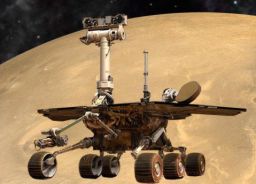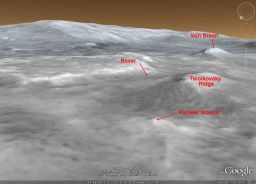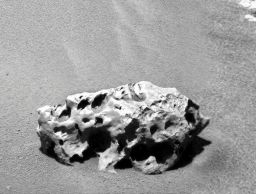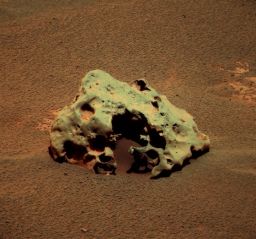A.J.S. Rayl • Oct 31, 2009
Mars Exploration Rovers Update: Spirit Overcomes Setbacks and Waits for Extraction Orders, Opportunity Takes a Magical Meteorite Tour
The Mars Exploration Rover mission logged another textbook-rewriting month in October 2009 with more discoveries of geologic gems, new robot achievements balanced with equal amounts of challenges and frustrations overcome, topped off with special honors.
Spirit spent most of the month overcoming a series of “mental” and physical challenges, but is hopefully awaiting the green light from NASA headquarters to begin the process of extracting itself from the sandy pit in which it's been mired since April. Opportunity, meanwhile, took its passengers on a magical meteorite tour as it continued on its long journey to the still distant Endeavour Crater. And on Earth, their tireless science leader, Steve Squyres, was honored with the Carl Sagan Award for excellence in public communication from the American Society of Astronomers (AAS).
Now, as October slips away and the autumnal equinox puts fall in Mars' southern hemisphere on the run, Spirit and Opportunity and the crewmembers who support them begin on All Hallow's Eve the long approach to their fourth Martian winter. Scary a proposition as Martin winter always is, the rovers remain undaunted as they head into November with power levels and masts held high, ready for the adventures that lie ahead.
For Spirit at Gusev Crater, October 2009 could be summed up in one word: tough. It managed with some effort to successfully overcome the problem with its high gain antenna’s dynamic brake, a series of glitches that began last month and slowed the rover’s work schedule down for several weeks.
Then, one week ago, on its Sol 2065 October 24, Spirit suffered another setback when its operating system suddenly re-set or rebooted. Following that unexpected event, the rover had a problem mounting its non-volatile flash memory over a four-sol period, according to the official explanation, meaning the rover lost all the data collected over 4 sols or Martian days. It was a case of robot amnesia.
 Steve Squyres
Steve SquyresSteve Squyres, principal investigator for the Mars Exploration Rovers and 2009 recipient of the American Astronomical Society's Carl Sagan Award for excellence in public communication, is shown here talking with a few hundred of the 4000+ people who contributed to the MER mission, during the 5th Anniversary Celebration, held Jan. 15, 2009 at JPL and Caltech in Pasadena, California.Credit: NASA / JPL-Caltech
Fortunately -- or not -- Spirit has experienced such events before, for the first time last April and on three subsequent occasions after that it suffered bouts of amnesia. During these episodes, the rover is working it seems but simply fails to record any of the data from the day's activities onto the type of computer memory -- non-volatile "flash" memory -- that can store and retain it even when the rover powers down for its energy-conserving periods of "sleep."
Having been through this before with Spirit, the team knew what to do and immediately began planning to send instructions to the rover to reformat its flash memory file system to restore it to normal operation.The setup for reformatting flash was uplinked today Saturday as part of the typical 3-sol weekend plan. The real-time commands that will make it happen won’t be sent until Monday afternoon, assuming, of course, a final Go/NoGo meeting on Monday, November 2, 2009, is still “Go."
It almost seems as if Spirit is getting anxious, at least for those who have been following this mission for any length of time. Certainly, the MER team is ready to move on from this place called Troy.
"Science-wise we're kind of just waiting to start turning wheels," Steve Squyres said during an interview Thursday. While there is more work they could delve into at Troy, which is one heck of a science-rich place to be stuck, the scientists have done what they really wanted to do there. "Right now, the resources we have are very much devoted at getting ready to move the vehicle," he said.
To that end, the engineers who have been working meticulously with test rovers on the ground to figure out the best way for Spirit to get itself out of its sandy predicament staged an operational readiness test on October 12. Basically, they initiated the plan on the ground replicate of the twin MERs, then left the laboratory for five days, only accessing it electronically and only analyzing and adapting to the rover's data from afar, like they do for real with Spirit and Opportunity every day. The extraction plan, which begins with crabbing up hill and moving forward, made progress and the ORT was deemed a success.
The MER team then presented the plan and the test results before a review board last Wednesday, October 28. "It went well," said Squyres. "Now the review board is going to write a report, then brief the decision-makers at NASA headquarters. At that point, we will hear what we should do." That briefing, according to various sources, could take place early next week.
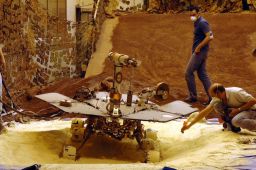 Testing exit maneuvers at JPL
Testing exit maneuvers at JPLEarlier this year, MER team members began testing exit maneuvers and strategies in the In Situ Instrument Laboratory (ISIL) at JPL, with the surface system test bed (SSTB) replicate of Spirit and Opportunity executing commands in what came to be called the "sandbox."
Credit: Mark Adler
While Spirit tugged emotional heartstrings with its ongoing saga of struggle and perseverance at Gusev Crater, Opportunity rocked socks off as the meteoric hits kept on coming from Meridiani Planum.
On the 15+-mile trek to its next big attraction, Opportunity made more rover history in October when it stopped to “smell” a couple more rocks, Shelter Island and Mackinac, that turned out to be metallic meteorites like Block Island, which it studied in-depth in August and part of September.
While these newfound meteorites are large, 47 centimeters (18.50 inches) and 45.2 centimeters (17.79 inches) respectively, Block Island, at about 70 centimeters (27.55 inches) or more than 2 feet long, still the king of the 'skyrocks' found by either rover to date. The discoveries of Shelter Island and Mackinac Island actually, though are rather impressive for a rover on a mission to keep moving. "It is indeed significant to find a concentration of meteorites in the same place," said Matthew Golombek, a MER science team member at the Jet Propulsion Laboratory (JPL), where Spirit and Opportunity were built and are being managed.
The discoveries become even more remarkable in that they appear to be alike and some scientists are mulling over the prospect that they may be from the same asteroid bombardment. "Since there's a bunch of them together here – three of them -- and since they have the same compositions, these are plausibly pieces of the same object that hit Mars and broke into pieces," Squyres said.
It is, as Spock would say, logical. As asteroid expert Donald Yeomans, a senior research scientist at JPL and manager of NASA's Near-Earth Object Program Office, put it: "You’d expect fragments from the same impact to be in the same general area, much as there were many iron meteorites neighboring Meteor Crater near Winslow, Arizona.
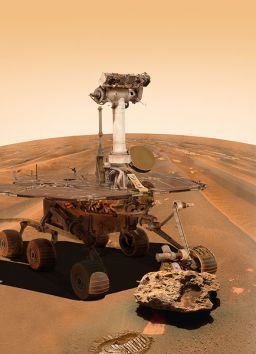 Opportunity at Block Island
Opportunity at Block IslandThis art shows Opportunity superimposed onto the Martian landscape near the iron-nickel meteorite Block Island, which just so happens to be the largest meteorite that either of the two MERs has found to date. If only someone/something really was filming the rovers ... thanks to Astro0 this art gives us a taste.Credit: NASA / JPL-Caltech / Cornell / FX by Astro0
But it may be that they're not from the same event. "Compositionally they seem similar which would argue they are from the same fall," Golombek agreed. "Unfortunately, there are lots more unknowns than knowns.” Thus, he added: “We do not know if they are from the same fall or not."
Given that it's too early to say if they came from the same asteroid bombardment or if they came from a fall at all, it's also too early to know when exactly they fell or what the atmospheric conditions were when they fell, Squyres said. There are multiple possibilities, he said, and urged everyone, especially the media, to err on the side of conservative interpretations for now.
The MER scientists have speculated whether or not chunks of asteroids this big could make it through the atmosphere of Mars today in one piece. Some of the scientists strongly believe they could not, something that implies that the atmosphere must have been denser when they arrived, a theory mentioned by Golombek and reported here in the August edition of the MER Update.
When the idea got picked up by the news, however, the theory was reported as near indisputable fact. Only it’s not really. “That the Martian atmosphere was denser when these things came in is a theory and it remains highly speculative," Squyres said. It's "plausible," he added, that these metallic gems did come through a Martian atmosphere similar to what exists today. "Certainly we have not done the work that would be necessary to prove they did not," he said.
The analysis is underway now though. "All the meteorites look very similar," said Ralf Gellert, a MER science team member of the University of Guelph in Ontario, Canada. "We're now in the process of assessing them."
Once Opportunity's business at Mackinac was done, it roved on, returning toward the end of the month to its most recent prime directive: "Drive, drive, drive," as Squyres summed it up. The rover is currently making its way around the purgatoid field and will soon head back to the east and continue on a more direct southward route to Endeavour, still more than a year’s drive away at its current pace.
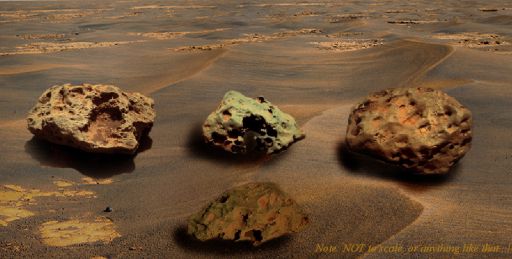 Mars' latest rock stars
Mars' latest rock starsThis image -- put together for the fun of it by Stuart Atkinson, a moderator and the "Poet Dude" at UnmannedSpaceflight.com -- shows the four iron-nickel meteorites that Opportunity found during its recent magical meteorite tour. Counterclockwise beginning at the bottom: Shelter Island, Block Island, Mackinac, and Heat Shield Rock. Atkinson posts his pictorial creations and his poetry on a blog called "On the Road to Endeavour." Check it out at: http://roadtoendeavour.wordpress.com/ Note: This image is not to scale, so hold the letters.Credit: NASA / JPL-Caltech / Cornell / assembled by Stuart Atkinson
On Monday, October 26, 2009, Spirit and Opportunity experienced their fourth autumnal equinox on Mars. Each crossed the milestone and emerged, despite Spirit's amnesia event, in good health, producing moderately robust amounts of power, ready to write new chapters, ready to rove on over new Martian hill and dale in November.
While attending a colloquium in New York on Thursday, October 29, 2009, Squyres took a break to talk MER. In addition to reviewing the latest events, he reflected on being honored with AAS’ Carl Sagan medal, which he accepted earlier this month during the Division for Planetary Sciences annual meeting held in Puerto Rico. He has forever made a habit of citing the marvels of the rovers and the team of hundreds, once thousands, he’s worked with and, of course, NASA’s backing, but he seemed differently humbled by this honor.
Anyone who has been lucky enough to even glimpse behind the scenes knows there’s something some thing really special about this mission team, the camaraderie, the almost uncanny respect between the engineers and scientists, the old-school can-do, failure-is-not-an-option attitude delivered with an updated rock-hip-hop-be-bop flair, and the ‘til-death-do-us-part devotion to a couple of aluminum and titanium ‘bots who have gone on to become global icons. By virtually all accounts, Squyres is at the center of it all.
For more than six years, as busy as he is heading NASA’s next Decadal Survey and working on other missions including the Mars Reconnaissance Orbiter (MRO), Squyres has put himself out there before the public on behalf of MER, chronicling the journey again and again, interpreting the science beamed down with metaphors the public and media alike can understand, teaching how rocks have stories to tell and doorways into ancient history to open, and turning the public on to the science of Mars in the friendliest of ways, with two robots that captured hearts, and with his help headlines, around the world.
Unlike most NASA missions, Spirit and Opportunity are taking people along for the ride, vicariously of course, via the Internet, and they’ve done it from the beginning. It was a courageous decision that in effect transformed the $900-million-dollar planetary expedition into the first science 'reality show' from Mars, accessible to anyone with a computer in near real time.
Since Spirit bounced down in January 2004, the MER team has maintained a database of images taken by the rovers that the public can tap at the same time as the team members. "If I'm asleep and you're awake, you can see the pictures from the rover before I do," said Squyres. Pipelining the data straight to the Web was a conscious and deliberate decision by the rover team, he added, and it “has really enabled people to share in this voyage of exploration." It’s also helped make MER the second most publicly recognized space mission, according to a CNN poll taken a few years ago. Only Apollo is better known.
Spirit and Opportunity of course have roved up to the plate, delivering meeting their prime objective of finding evidence of past water during the 90-day primary mission, then delivering the gold of discovery again and again. As a result, MER has become a landmark mission and Spirit and Opportunity have become not only robot heroines, but legends in their own time.
It’s almost impossible to imagine this mission without Squyres, who is by title the Goldwin Smith Professor of Astronomy at Cornell. In fact, he knew Sagan pretty well. Actually, Squyres worked closely with the beloved astronomer and co-founder of The Planetary Society back in the late 1970s, early 1980s when Sagan was the David Duncan Professor of Astronomy and Space Sciences at Cornell and Squyres was a graduate student, the rovers not yet even a glint in his eyes. He learned much, he said, from “the master.” If things had gone as planned, Sagan would have celebrated his 75th birthday this November 9.
 Squyres, Schwartzenegger and Weiler
Squyres, Schwartzenegger and WeilerJPL was the place to be in January 2004. No one knew that better than California Governator Arnold Schwartzenegger who visited the Flight Operations facility after Opportunity's successful landing. Squyres listens to the comm for further news, with Arnold and NASA's Ed Weiler. Created: 24 January 2004.Credit: The Planetary Society
"It's very special to me of course," Squyres said of the award. "Carl was an inspiration to a lot of people. I was certainly among them. One of the many things I learned from him is that those of us who are fortunate enough to work in this business and who are privileged to spend enormous amounts of taxpayer resources have a real responsibility to let the public know what they're getting for their investment in very clear and unambiguous and comprehensible terms. Not only was Carl the master of that, but he was also a pioneer in doing that. He showed the way for how that kind of thing should be done. Many of us have done the best we can to get the message out in a way that would have made him proud.” He paused for a moment. “This is a real honor," he said.
More than anything and in the spirit of Sagan, Squyres said that he hopes MER has encouraged young people to pursue careers in science and engineering. "NASA does all kinds of wonderful things in space, from cosmology to gamma ray spectroscopy," he said. "But try explaining gamma ray spectroscopy to a third-grader. It's hard." Spirit and Opportunity, on the other hand, are a couple of identical twin robot field geologists roaming around on Mars looking at rocks – and that's something fairly easy for most anyone in a post-StarTrek civilization to understand. It's because of that the MER mission is, as Squyres described it, "almost uniquely accessible to people."
That alone, no doubt, would have made Carl Sagan proud.
Although the science’s world’s most gifted storyteller and longtime planetary explorer passed away on December 20, 1996 at the age of 62 and never got to take part in any the day-to-day adventures of MER, a mission he indirectly influenced, this much is certain: the inspiration Sagan imparted over nearly four decades lives on and with every rove they take, Spirit and Opportunity, Squyres, and the entire MER team are paying that inspiration forward.
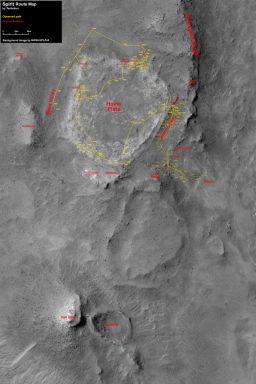 Spirit route map
Spirit route mapThis image taken by the HiRISE camera onboard the Mars Reconnaissance Orbiter has been labeled by Eduardo Tesheiner, an active participant on UnmannedSpaceflight.com, to show Spirit's route from its arrival in the Home Plate area on Sol 743 through Sol 1871 (April 8, 2009), when the rover began suffering a series of bouts with 'amnesia.'Credit: NASA / University of Arizona / annotation Eduardo Tesheiner
Spirit from Gusev Crater
As September turned to October on Gusev Crater, Spirit was running through basic, preprogrammed engineering and science tasks in X-band fault mode, sitting as it had been since April – its left three wheels mired in sand and loose Martian dirt after encountering what turned out to be a shallow crater called Scamander – waiting on instructions from its crew.
The rover’s high gain antenna (HGA) system had been on the fritz for a while with faults occurring twice on the dynamic brake in September and again in early October. The HGA is the primary antenna the crew uses to send up large the large engineering and science command loads, so it caused a slowdown in the rover’s work schedule. The good news is that Spirit was never in danger, nor did it ever lose touch with its team, because of the redundant or back-up systems designed into the MER vehicles and NASA’s Mars communication network for unexpected incidents just like this.
The engineers immediately switched to the rover’s low-gain antenna (LGA) to send their X-band uplinks. Bandwidth with the low gain antenna, however, is really limited, so the rover was pretty much on autopilot, conducting ‘runout’ sequences, the first week of the month as engineers figured out when to send up the 'repair' sequences.
Although Spirit had been embedded and "mobility impaired," as Ray Arvidson, deputy principal investigator, of Washington University St Louis, puts it, for months and taking thousands of pictures of everything under it and around it, it was only in mid-August that Arvidson determined that the rover had actually, ever so accidentally, come upon the stealth crater with its left three wheels.
"This thing we've been calling Scamander Plains is actually a very shallow crater, probably a secondary impact crater, and we're sort of perched on the lip of it," Squyres explained. "It's filled up with pretty loose material, which is probably responsible for the fact that we have different traction on the two sides of the vehicle," he added. It doesn't jump out as a crater in their topographic maps. "But if you fit a plane to that map and tilt it, then it really jumps out, and it was Ray who really caught onto it," Squyres said.
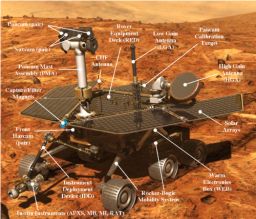 The body of a MER
The body of a MERThe Mars Exploration Rovers are robot field geologists that were designed with parts to substitute for the organs all living creatures would need to stay "alive" and able to explore, as well as some super-human powers. Spirit and Opportunity, for example, each have a body that protects its "vital organs;" brains to process information; temperature controls, including internal heaters, a layer of insulation; a "neck and head" formed from a mast for the panormaic camera for a human-scale view; eyes and other "senses," such as cameras and instruments that give the rovers information about their environment; an arm to extend its reach; wheels and "legs," necessary for mobility; and energy sources in the form of batteries and solar panels; and antennas for "speaking" and "listening."
Credit: NASA / JPL-Caltech
Arvidson named it for the Scamander of Greek mythology (aka Skamandros, Xanthus), a river god, son of Oceanus and Tethys or son of Zeus, depending on whose version you believe. All the ancient historians do seem to agree that with Idaea, he fathered King Teucer. As Homer reported it, he was called Xanthos by gods and Scamander by men – and that, according to Wikipedia, might indicate that the former name refers to the god and the latter one to the river itself. In any case, for those following the target labeling schemes, Arvidson chose "Sacamander crater with Scamander plains, because the Scamander plains outside of Troy is where the Greeks fought the Trojans."
On Sol 2045 (October 3, 2009) Spirit took another series of Microscopic Imager (MI) pictures, reaching underneath its belly with the short-focus camera mounted on the end of its arm to get another angle on Belly Rock, the pointy rock that may or may not be touching Spirit's underside. Belly Rock is still the big known unknown factor in the coming extraction. The team members have put all the data and all their ideas on the table and the only thing everyone agrees on right now is what they don’t know. They don't know, for example, whether Belly Rock is a big and deeply embedded boulder or a smaller stone that is loose; consequently, they don't know whether it’s going to be a serious problem or simply a mere annoyance.
Spirit also conducted another test of the HGA dynamic brake that same sol and found everything working as it should. The team planned to take their 'bot out of the X-band fault mode on Sol 2050 (October 9, 2009) and have it conduct a long-duration motion test, moving the HGA in all directions, to make sure it's fully operational.
As the first week of October came to a close, Spirit producing a healthy 423 watt-hours and reporting a dust factor of 0.603, thus was continuing to take in about 60% of the sunlight that hit its solar arrays. The dust fallout from the spring storms still hung in the skies overhead, but continued to dissipate slowly and the tau, or rover measurement for dust, dropped slightly, to a hazy 0.657.
On Sol 2052 (October 11, 2009), the HGA brake anomaly recurred and once again the engineers transferred all X-band uplinks to the low-gain antenna. The engineers worked to bring the rover back under normal HGA operation by Sol 2054 (October 13, 2009), but an unexpected Deep Space Network (DSN) station outage -- with no alternative station available -- prevented the HGA-recovery uplink from getting to Spirit. It was starting to get spooky, appropriately enough for October, as if Mars was throwing up every roadblock possible.
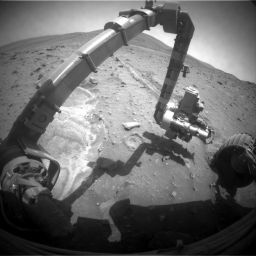 Looking forward
Looking forwardSpirit recorded this forward view of its arm and surroundings during its Sol 2052 (Oct. 11, 2009) with its front hazard-avoidance camera. Bright soil in the left half of the image is loose, fluffy material churned by the rover's left-front wheel as it drove backwards, approaching its current position in April 2009. That's when it's left three wheels broke through a darker, crusty surface. Deputy Principal Investigator Ray Arvidson figured out that Spirit had accidental slipped slightly into a shallow crater -- dubbed Scamander -- hidden beneath the fluffy material the rover had churned up. The turret of tools at the end of the rover's robotic arm is positioned with the Mössbauer spectrometer up and the rock abrasion tool (RAT) extending toward the right. Spirit's right-front wheel, visible in this image, has not worked since 2006. It is the least-embedded of the rover's six wheels at the current location in an area called Troy.Credit: NASA / JPL-Caltech
Spirit carried on, conducting preprogrammed, runout science and engineering sequences, as the team planned the next repair uplink for Sol 2057 (October 16, 2009). That uplink would reset the system to clear the X-band and HGA faults and change the communication behavior manager back to normal or X-band nominal.
Meanwhile, whenever possible, the engineers sent major commands, such as data management bundles and science sequences via the forward-link commanding through the Mars Odyssey orbiter and so Spirit did get some decent remote sensing science in, but the engineering took priority for obvious reasons.
The solution that was to arrive in the uplink would effectively mask the HGA’s dynamic brake in the flight software. The engineers had seen these dynamic brake failures before on steering actuators way back during the first Earth year of the mission and had done this before. “While there were many different possible failure mechanisms, the most likely was the build-up of what is called 'wear polymer' on one of the relay contacts,” explained Bill Nelson, chief of the rover engineering team at JPL.
“We have relays that open and close – close to provide the short, which is the brake, or open, which releases the brake,” he explained. “But we don't sense that directly. We sense by using an extra contact. These are all mechanically linked through an armature, a 4-pole relay, so all four either open or close together. The shorting contacts when they get any juice in them at all are likely to have substantial current as far as the relay is concerned. It may be just be a few milliamperes, but the sensing contact doesn't get nearly as much current through it. Because the sensing contact doesn't have the energy in there, it tends, if there's any contamination, such as out-gassing or anything in the relay – and there always is because you can't make them that perfect – not to have enough energy to burn it off or cause it to volatilize, so you get the build-up of this gunky substance called 'wear polymer,'” he said. Just to be clear, the putative "wear polymer" is expected to be a microscopically thin coating, invisible to the eye. But it can still make a difference.
If the relay is closed, eventually the pressure of the two contacts will cause the wear polymer to ooze out of the way. And the MER team did some tests that showed after half a second to a second or so, the dynamic brake state changed. “But the flight software is expecting this to switch much more rapidly – average time around 4 milliseconds – so by the time it actually does make contact, the flight software has already long since made a decision and declared a failure,” Nelson explained.
That scenario leaves them with two choices: lengthen the delay in flight software, “a long and difficult process,” said Nelson or they could simply mask off the check. Which means basically that the flight software no longer checks to see if the dynamic brake is on or not, the assumption being that it is working fine, if a little slow.
 Home Plate
Home PlateSpirit acquired this full resolution mosaic of Home Plate on Sol 1886 (April 23, 2009). The image was taken before a drive, as the rover made its way around the western edge of the circular volcanic formation. The field of view spans about 90°and this mosaic, in approximate true color, was created from Pancam's 753-nanometer, 535-nm, and 432-nm filters.The rover subsequently became embedded in the spot from which it took the pictures that went into this mosaic.
Credit: NASA / JPL-Caltech / Cornell University
“As you might expect, a possible failure might be that the brake is on,” Nelson continued. “But there is a series fuse, so that if the brake is on and, if you still try to use the motor, you will blow the fuse, which then opens the brake. The downside to that is that you can never re-apply that brake again, but must rely strictly on your magnetic detent to hold your position.” That, it turns out, is not that big of a deal. “We believe the detents will hold up to some pretty significant G-forces and even at that point probably not move the antenna too far out of position.” The magnetic detents can hold the antenna against such forces, he said, because the gearing between motor and antenna decreases those forces by the gear ratio of about 5000:1.
Spirit continued into mid-month conducting limited remote sensing science in the runout programs, in otherwise good form, producing a healthy 427 watt-hours, thermally stable, and communicating under still hazy skies.
Meanwhile, down on Earth, the MER engineers preparing for Spirit's coming extraction put the surface system test bed (SSTB) rover through an operational readiness test or – by NASA acronym – an O-R-T on October 12, 2009. Basically, the team members commanding the drives initiated the action, then left the sandbox or In Situ Instrument Laboratory (ISIL) at JPL, to assess from a distance and only from the images and other data communicated from the test rover how well it carried out its commands, just like they Spirit and Opportunity almost every day.
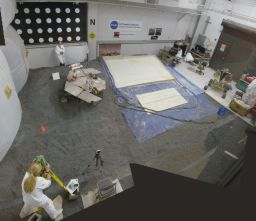 ISIL in August
ISIL in AugustOn August 25, 2009 on the Mars Exploration Rover side of the In-Situ Instrument Laboratory (ISIL) at JPL, rover engineers were test-driving the engineering model of the rover (known as the Surface System Testbed or SSTB) on a sloping surface composed of coarse sand. Next to it sits the sandbox containing a mixture of materials designed to simulate the behavior of the soil at Troy on Mars, where Spirit was stuck. In the foreground, rover driver Sharon Laubach uses a theodolite to measure the SSTB's position after a test of driving in a crablike motion. In the background on the right, the SSTB Lite -- a stripped down, Mars-weight engineering model of the rover -- waits to perform similar tests.
Credit: Emily Lakdawalla
The test ran five days on an accelerated schedule of two Martian days' worth of commanding every day. "We conducted this round of testing under more flight-like conditions to test the team's ability to make very complex extraction driving decisions using only the data sent back from the rover," said MER Project Manager John Callas, of JPL.
Back on Mars, as the third week of the month took hold, Spirit placed its Mössbauer spectrometer on a surface target nicknamed Thoosa, to resume an extended integration on Sol 2057 (October 16, 2009). The most important activity of that weekend though – at least the most stress-relieving – was Spirit's uploading of commands that effectively put it into recovery from the X-band fault and enabled it to use and steer its HGA normally again.
On Sol 2058 (October 17, 2009), the MER team sent up commands and Spirit successfully cleared the X-band and HGA errors and resumed normal HGA X-band operation. "The HGA has been returned to service without any further problems," Nelson confirmed earlier today. "It is believed the fuse is not blown and thus the brake is being applied and released normally. We just don't test for it any more."
After devoting several sols to collecting Mössbauer spectrometer readings on Thoosa and searching for dust devils with the navigation camera (Navcam), Spirit, with its HGA back in full swing, picked up the pace of science on Sol 2059 (Oct. 18, 2009), continuing its campaign of taking pictures of Scamander Carter and Scamander Plains with its panoramic camera (Pancam). It also spent quality time collecting compositional data on Pioneer Mound with its miniature thermal emission spectrometer (Mini-TES).
Pioneer Mound is one of the unusual mounds south of Spirit’s location at Home Plate. It lies to the west of Tsilokovsky Ridge. Von Braun, the mound that has long been Spirit’s next destination is located on the eastern side of Tsilokovsky Ridge. [See image]
From the Mini-TES data, Steve Ruff, of Arizona State University and the science lead on Spirit’s Mini-TES, identified Pioneer Mound as a possible outcrop of eroded silica like the rover encountered east and north of Home Plate. “The mound is several meters in diameter and about a meter high,” Ruff informed. Unfortunately the instrument is still handicapped by the dust taken on during the global storm of 2007. “The Mini-TES observations are challenging given the horrible mirror dust,” he admitted. “But one recent observation provides a hint, although not yet robust, that it may indeed be silica-bearing. My hope is to get more spectra that may be definitive.” More is surely to come from that front.
Early in the morning of Sol 2061 (October 20, 2009), Spirit woke up and checked out its T-stat box, a thermostatic switch designed as a built-in safety mechanism to provide protection against overheating. Then, it collected another 11-frames for an MI mosaic of Belly Rock and the dangers that may lurk underneath it. As the rover reached beneath itself once again, it came in at a different angle than all the other sessions with the close-focus camera on the end of its arm to take another snap-see.
Even though this series of underbelly mosaics are blurry because the MI camera was designed for close-up microscopic imaging, hence its name, and not taking snapshots, these images have been "tremendously helpful" in the extraction assessments, said Squyres. "Nothing has changed under there, but we're trying to characterize the geometry of the stuff underneath the vehicle, particularly Belly Rock, as thoroughly as we can to get all the information we can,” he said.
One of the obvious reasons for getting a good look at Belly Rock is because as soon as Spirit starts moving, understanding the interaction of the vehicle with that rock will be critically important. “We don't know if that rock is rooted and is a hard obstacle that will not move or something we can tip over with the slightest motion or something somewhere in between,” Squyres reiterated. “So monitoring what happens to Belly Rock is very important to us -- it's before and after imaging right? We want to make sure we get the before part right."
While the rover's power production fluctuated as usual, Spirit overall maintained healthy levels above 400 watt-hours, reporting levels of 410 watt-hours on Sol 2062 (October 21, 2009) and a dust factor of 0.594. The dust in the atmosphere continued to dissipate and the tau dropped slightly again to 0.570.
 Looking underneath in 3-D
Looking underneath in 3-DThis stereo view combines a pair of images Spirit took two months apart with its short-focus microscopic imager. Rover team members used the MI camera on the rover's arm to accomplish something never intended during the design of the robot or that camera -- getting a look underneath the rover. Even though they knew the image would be blurry the MER team wanted to get a better look at Spirit's predicament. The dark triangular shape is a rock that is either touching or nearly touching the rover's underbelly. The two images combined here come from two camera positions, one slightly to left of the other, yielding a three-dimensional view when seen through red and blue glasses with the red lens on the left. One image was taken on Sol 1925 (June 2, 2009); the other during Sol 1990 (Aug. 8, 2009).
Credit: NASA / JPL-Caltech / USGS
Just when Spirit seemed back on track and its team was preparing to present its extraction plan to a review board, the rover on Sol 2065 (October 24, 2009) suffered another minor setback when it suddenly rebooted itself and then had a problem "with mounting its non-volatile flash memory," as the official confirmation put it. The data Spirit sent data home from that sol through Sol 2068 (October 27, 2009) indicated that it hadn’t used its flash memory. In other words, for four sols the rover forgot to record and store the data gleaned from the tasks assigned.
Spirit first exhibited this bizarre behavior back in April of this year, when its experienced a couple of resets and four bouts of amnesia over the course of several weeks, but the team was unable to figure out exactly what triggered them. They were waiting for this event and may well get to the bottom of it as a result of it happening again.
"We still don't have information about what causes these amnesia events," said John Callas, MER project manager yesterday. "If they are intermittent and infrequent, they are a nuisance that would set us back a day or two when they occur. If the condition becomes persistent or frequent, we will need to go to an alternate strategy that avoids depending on flash memory."
The MERs, of course, have alternate memories so even if the flash memory was lost, it would not be mission threatening. The memory however is volatile random-access memory or RAM. That means the rover can save data there for communicating to Earth as long as it is awake. In other words, it must beam up the data the same day it collects it, or at least before it goes to sleep. If the mission had to relay on the rovers' RAM they would only get data collected the same day. Any unsent data from an earlier day would be lost, Callas noted. Nevertheless, he added: "The total volume of data returned by the rover is expected to be about the same."
Earlier this week, Spirit resumed activities using only its RAM to store telemetry, so the team instructed the rover to stay awake until its afternoon relay pass with Odyssey so it could return the day's data before napping and losing the goods.
It's another bump in what has been an unfairly bumpy road for Spirit and it may delay the start of the rover’s coming extraction. But from all appearances and nearly six Earth years of past history, it’s certainly not enough to stop this rover or this rover team.
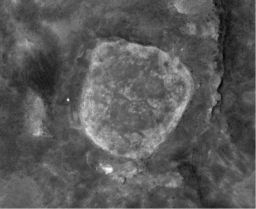 Spirit at Troy
Spirit at TroyThe little white dot on the left side of this image is Spirit. It is on the western side of Home Plate in an area the team calls Troy waiting now for the green light to start moving again. This image was taken by the University of Arizona's HiRISE camera, which is onboard the Mars Reconnaissance Orbiter.
Credit: NASA / JPL-Caltech / UA
As engineers at JPL prepared to reformat the rover's flash memory file system and restore it to normal operation, Spirit hung in, otherwise in good health and maintaining strong power levels. The setup for reformatting flash was uplinked in the Sol 2072-2074 plan and should have arrived today, if everything went as planned.
"Flash is partitioned into two parts," said Nelson. "One part is simple memory; the other is configured as a disk drive. In fact, we licensed the disk drive technology from Sandisk. We believe the configuration area of Flash is corrupted and this is why the file system or disk drive won’t 'mount.' We note, however, that the other part of flash, the regular memory part, holds most of the flight software which has been operating normally," he added. "By reformatting flash -- which only reformats the file system area so we won’t lose the flight software -- we believe the process will identify the old configuration area as bad, mark it so, and build the new configuration area elsewhere. This should allow the system to be configured and mounted and thus restore normal operation."
The plan right now is to send up the real-time commands to initiate the reformatting on Monday afternoon, November 2, 2009. That plan could always change depending on any number of things, not the least of all Spirit. It won't, however, happen all at once.
Flash is actually reformatted in two steps. "On the first step, we set a flag," said Nelson. "On the next wakeup, flash will be reformatted. On the second step, we reset the flag; otherwise, flash will be reformatted and reformatted, ad infinitum." Monday is step one.
Timing is everything, they say, and the Spirit team members know this well because they've lived it. Hours after Spirit’s extended bout of amnesia, the team had to present its extraction plan and the results of the ORT to a review board. Like their charge, the team carried on. "The project team did a great job," commended Squyres, "and the review board is off deliberating and writing their report."
‘Mum’ seems to be the word on the details of review, even as the team prepares to makes its case for extraction before NASA's Associate Administrator for the Science Mission Directorate, Edward J. Weiler possibly early this coming week. “We gotta do this right,” said one team member. Scuttlebutt around the Lab, however, revealed that there was a lot of talk in the review about the team being adaptive, not really surprising given the uncertainty principle of Mars and the fact that the team has almost redefined the word 'adaptive' with this mission.
Squyres confirmed that. "Once we eventually start turning wheels on Mars, it's going to be so important that we take our time to assess the moves very carefully and whatever plan we go forward with, we're going to have to be prepared to adjust that plan, modify it and maybe discard it completely and try something new based on what we see on Mars," he said. "We've learned all we can from testing on Earth. The real knowledge base is going to come from moving the vehicle on Mars and we're eager to start doing that when we get all the necessary approvals."
When the Sun set on October at Gusev, Spirit was producing more than 400 watt-hours of power and the dust in the skies seemed to have stabilized its haze as the tau hovered around 0.599. The rover’s odometer still reads: 7,729.97 meters (4.80 miles). But the team is hoping that changes soon. For now, Spirit is sitting tight, waiting for the associate administrator to get his briefing -- and then for his decision.
Opportunity from Meridiani Planum
Opportunity roved into the month of October on Sol 2022 with a 28.5-meter (94-foot) backward drive to the west and south, pushing ahead on its ambitious journey to the gargantuan Endeavour Crater.
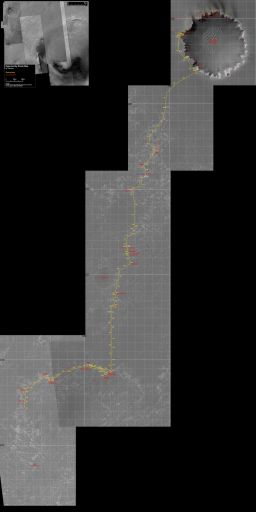 Opportunity route map
Opportunity route mapThis route map -- which is comprised of images taken by the CTX and HiRISE cameras onboard the Mars Reconnaissance Orbiter -- shows Opportunity's route from Victoria Crater through its Sol 2048 (Oct. 27, 2009). It was annotated byannotated by Eduardo Tesheiner, a senior member of UnmannedSpaceflight.com.Credit: NASA / JPL-Caltech / UA / MSSS / annotated by Eduardo Tesheiner
It was still roving along the edge of a field of large rippled sand dunes -- not so affectionately dubbed purgatoids after the rover's frightening encounter back in April 2005 – on approach to another hunk of rock that looked a lot like a meteorite. The rock looked a lot like Block Island, the iron-nickel meteorite the rover spent all of August into September checking out with its spectrometers and cameras.
The rover and the MER team saw Shelter Island, as it’s now known, in routine remote sensing images from the final days of September. As it turned out, less than three weeks after driving away from Block Island, Opportunity was on to another sizeable iron-nickel invader. Following the drive, it took the traditional pictures with its navigation camera. This 'skyrock' is nowhere as big as Block Island, but it does feature the same type of “cavernous” holes, as Squyres described them, and texture.
On Sol 2024 (October 3, 2009), Opportunity turned around with a 2-meter drive to face the meteorite. A final 1-meter (3-foot) bump on Sol 2027 (October 6, 2009) put the rover in just the right position to begin studying the new find with the instruments on its robotic arm, also known as its instrument deployment device (IDD).
Like Block Island, Shelter Island is indeed an iron-nickel meteorite that looks something like a petrified sponge. Analysis revealed it to be 47 centimeters (18.5 inches) long, 10 inches shorter than Block Island, which is about 70-centimeters (28-inches) or more than 2 feet in length. That means Block Island still reigns as the largest meteorite found on Mars by either of the rovers.
As the first week of October shuttered at Merdiani Planum, Opportunity was producing 449 watt-hours, with a dust factor of 0.5695. The haze increased slightly as the rover team found the tau up slightly to 0.638.
The rover spent the second week of the month mostly on its checkout of Shelter Island, taking a series of pictures with its microscopic imager (MI) for a mosaicked image and placing its alpha particle X-ray spectrometer (APXS) on a chosen spot on the meteorite on Sol 2029 (October 8, 2009).
Just two sols later, the rover lifted its arm from the meteorite and took some final documentary images with its panoramic camera (Pancam). Then, on Sol 2032 (October 11, 2009), it drove a 10-meter (33-foot) circle around the skyrock, much like it did with Block Island, to image and document the backside. Three sols later, the rover sailed on from Shelter Island, driving backwards for 64 meters (210 feet).
Cruising into mid-month with 446 watt-hours of power, Opportunity was on its way toward yet another possible meteorite, heading northwest this time. It was another historic drive for on Sol 2034 (October 14, 2009), the rover ticked off the 18-kilometer mark on its odometer, establishing a new rover drive record, pushing its total odometry as of that memorable sol to 18,036.06 meters (11.21 miles).
As the third week of October set in, Opportunity was beginning its examination of the new meteorite, dubbed Mackinac and as it did with Block Island and Shelter Island, the rover circumnavigated Mackinac, taking pictures as it circled the ancient invader.
Based on the images and data the rover sent home, the team found Mackinac to be an iron-nickel meteorite 45.2 centimeters (17.79 inches) in length. "Both Shelter Island and Mackinac Island are iron-nickel meteorites, both of them heavily weathered, with a very spongy and porous type texture and along with Block Island are 1AB iron meteorites,” summed up Squyres.
Iron meteorites are generally believed to be fragments of the cores of larger ancient asteroids shattered by impacts. “Some large asteroids formed differentiated layers with loose material on the surface, silicate rock as the intermediate mantle region, and nickel-iron in the core,” explained JPL asteroid expert Donald Yeomans. “Once formed, subsequent collisions created smaller asteroids from all three layers.”
Wherever exactly they came from, the “island” meteorites are Martian now, the climate and conditions on the Red Planet turning them into organic art that dots the rusty red landscape. “We feel pretty confident that all that weathering took place after the meteorites landed on Mars," Squyres offered. "It didn't happen out in space and it didn't happen on their way through the atmosphere." The MER scientists have a whole new mystery on their hands.
"It's just been fascinating," said Squyres. "We're having a wonderful time developing ideas for what could have resulted in that weathering and what that tells us about Martian environmental conditions."
From the compositional analysis conducted so far, these Opportunity-found meteorites contain on average “about 8% metallic nickel” in the iron matrix, along with "traces of germanium and gallium, consistent with a lot of the iron-nickel meteorites we know from Earth," informed Ralf Gellert, of the University of Guelph in Ontario, Canada. “Possibly,” he added, "there are also S or P containing minerals in the bulk.”
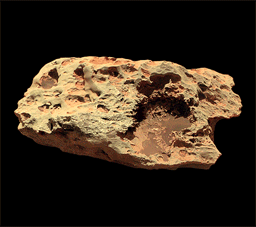 A tour around Block Island
A tour around Block IslandOpportunity captured these six views of the huge meteorite named "Block Island" from sols 1,959 to 2,002. A Quicktime version of the animation is available here (26 MB).Credit: NASA / JPL / Cornell / color composites and animation by Astro0
Block Island, Shelter Island and Mackinac Island each also bear the Widmanstatten pattern, which that is according to Yeomans, a "fingerprint" of iron meteorites.
This pattern is caused by the intergrowth of kamacite and taenite, informed Tim McCoy, of the Smithsonian Institution. "The taenite is the original mineral and forms an octahedron -- two pyramids stacked base to base -- and kamacite forms on the sides of this octahedron." This pattern, is also seen, for comparison, in the meteorite found back in the 1950s in Ft. Stockton, Texas, noted in a previous MER Update.
The Widmanstatten pattern is “extremely common in iron meteorites on Earth, but is not found in meteorites with very low nickel concentration (~5 wt.%) or very high nickel concentrations (more than about 12 wt. %),” added McCoy.
"My suspicion is that these are all part of a strewnfield," said Squyres, an area where meteorites from a single fall are dispersed. "These occur on Earth where you have an impact and the impactor breaks up either on the way in or after its impact and you have pieces lying around," he pointed out. "For example, there are pieces of the meteorite that created Meteor Crater that have been discovered a significant distance from the crater itself."
Not surprisingly, the debate is on and heating up behind the MER scenes. “Nothing speaks from the elemental composition against the theory that they are from the same original broken up meteorite," said Gellert. On the other hand, there are other clues, according to Golombek. "One possibility is they have accumulated here because of the geology of this location at the rim of an old crater," he offered. "They have very different erosional states, which suggests they have been on the surface a different amount of time or experienced different erosional environments."
There has been a significant amount of media coverage lately about the size of Block Island and these other iron meteorites and how much their size matters. One theory maintains that these meteorites are just too large to have plunged through Mars' current thin atmosphere and hit the ground without being obliterated upon impact. Which, extrapolating, means that they must have coming hurling in when Mars had a much denser atmosphere.
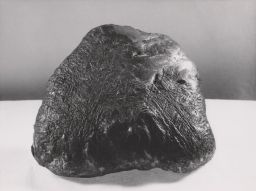 Fort Stockton meteorite
Fort Stockton meteoriteThis iron-nickel meteorite found near Fort Stockton, Texas in 1952 shows a surface texture similar to some portions of the surface of Block Island, the iron-nickel meteorite that Opportunity found on Mars in July 2009. The Fort Stockton meteorite is about 15 centimeters (6 inches) across and is in the collection of Texas Christian University. The triangular pattern visible on the surface is known as the Widmanstatten pattern and is commonly seen inside iron-nickel meteorites that have been cut, polished and etched. On the Fort Stockton meteorite and apparently on the Block Island meteorite on Mars, long exposure to wind-blown sand has brought out the texture.Credit: Smithsonian Institution
"Block Island is massive enough that models suggest it is difficult to land in the current atmosphere and that a thicker atmosphere would be required. If true, one possibility is that they fell when Mars was warmer and wetter and thus likely had a thicker atmosphere, which would likely be more than 3 billion years ago,” Golombek explained.
While the talk and debate is ongoing, that theory has been all but turned into fact in various media reports. “It’s only a theory,” said Squyres this past week. "We do not know if they fell at the same time or how long ago they fell,” added Golombek in concurrence. Or, for that matter, what the atmosphere was like when they fell. It could be, Squyres noted, that the big stones did come through a thin Martian atmosphere.
It could be, too, that the “island” meteorites are related to Heat Shield Rock, the much smaller 'skyrock' that Opportunity discovered toward the end of 2004, lying near the protective heat shield it jettisoned on landing, now some 11 miles away. Or not. "They seem to have the same composition as Heat Shield Rock," Squyres said. "One thing that makes Heat Shield Rock different is that it does not show this spongy, cavernous weathering texture that the other ones do show.” Which is downright intriguing.
The “sponginess” and “cavernous” holes may well be evidence of past water in the weathering process, but Squyres again urged caution in interpretation. "That is one plausible interpretation, but I'm not ready to say that is the interpretation.”
Much more analysis is still to be done on Earth of course, but for Opportunity once its business at Mackinac Island was finished, that meteorite was rover history, left sitting in a tiny cloud of Martian dust. On Sol 2038 (October 17, 2009), the rover ripped off another 70-meter (230-foot), drive backwards, again to the west and south.
Two sols later, Opportunity put the pedal to the metal again and logged another 72 meters (236 feet) on its odometer. And on the sol after that, 2041 (October 20, 2009), the rover made a similar 71-meter (233-foot) drive, still flanking the edge of the purgatoid field. By the end of the third week of October, the rover was averaging about 430 watt-hours of power, driving under moderately hazy skies.
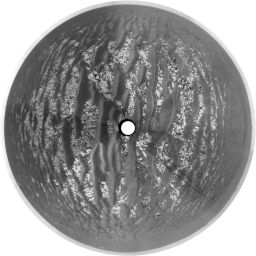 A world of dunes and rock
A world of dunes and rockOn its Sol 2034 (Oct. 14. 2009), Opportunity roved to a relatively bedrock-rich spot among the Meridiani dunes. A meteorite named Mackinac, the third it had investigated in recent weeks, sits at about the 7:00 position, close to the rover. This image is a polar projection of a 360-degree Navcam panorama captured by the rover after a 60-plus-meter drive to the northwest. The direction of the drive was almost directly away from Opportunity's eventual goal of Endeavour Crater, but it placed the robot field geologist on a large area of bedrock that continues for some distance to the south.Credit: NASA-JPL / mosaic Damien Bouic / polar projection Phil Stooke
To the team's delight, Opportunity doesn’t seem to be having any trouble with its right front wheel motor. Throughout October, the motor currents drawn by the rover’s once "hot" wheel continue to remain "well behaved," as the rover engineers define it.
"The right front wheel current has been in family with all the other wheels," Squyres confirmed. "The strategy we're using seems to be going well and we're going to assess whether we can stretch our legs a little more. We've been limiting drives to 70 meters so we can gather a good, consistent dataset for wheel behavior. But once we feel we've done that, we'll see if we can stretch out our drives and make them a little longer."
Opportunity opened the elevation mirror of its miniature thermal emission spectrometer (Mini-TES) each sol in hope Mars would produce just the right little gust to clear some of the putative dust off the elevation mirror. Unlike the Mini-TES on Spirit, Opportunity's mineral-seeking instrument is riddled with dust and not being used for remote sensing at all. But this month, like the month before and the month before that, brought no improvement. No one is giving up yet.
After its meteoric tour, Opportunity really cut loose, wrapping up the month of October with drive after drive after drive. Seemingly true to its carefree temperament, the rover cruised along on Sols 2043, 2045, 2047, 2048 and 2049 (October 22, 25, 27, 28 and 29, 2009), logging more than 280 meters (918 feet) total and pushing its odometer to 18,622.44 meters (11.57 miles). Heading more to the south now, it's roving around the point of the purgatoid field. As November dawns the plan ahead is simple said Squyres: "keep on driving."
The Time is Now.
As a Planetary Defender, you’re part of our mission to decrease the risk of Earth being hit by an asteroid or comet.
Donate Today

 Explore Worlds
Explore Worlds Find Life
Find Life Defend Earth
Defend Earth


